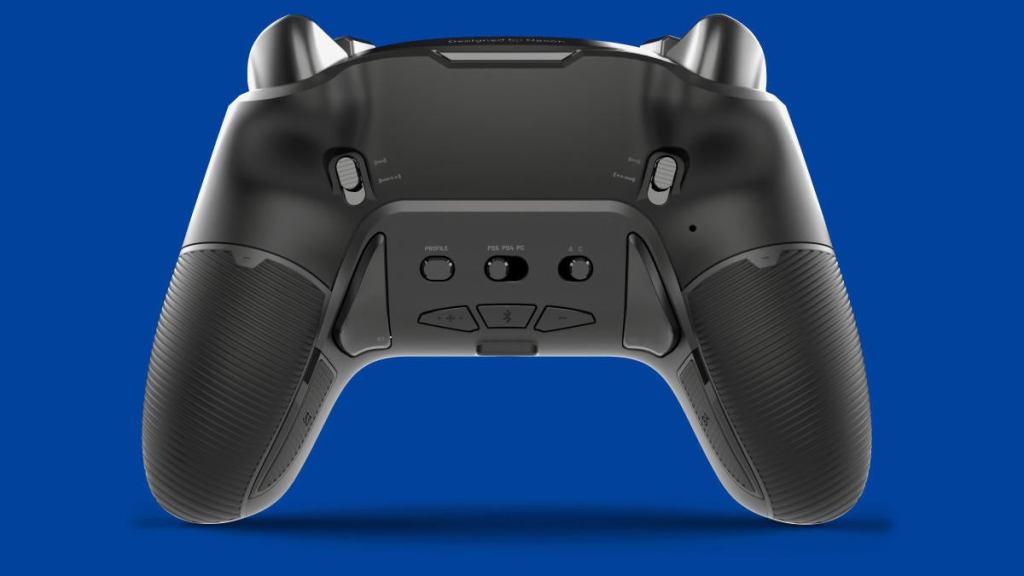Another PlayStation 5 controller is out on the market now with Nacon releasing its Revolution 5 Pro just recently. As the “5” in the name suggests, it’s a controller that’s made first and foremost for the PlayStation 5, but if you so desire, it works with PlayStation 4 games and on the PC, too. It’s a chunky, weighty controller that’s got all the bells and whistles that premium peripherals promise these days, and while it certainly feels quite comfortable in-hand, it only does so much to stand out amongst a crowd of options that’s becoming denser by the day.
Videos by ComicBook.com
The first thing that you’ll notice about the Revolution 5 Pro is how it feels so different from the PS5’s base DualSense controller as well as competitors like Xbox’s latest Elite controllers. Nacon’s Revolution 5 Pro feels wider overall and thicker around the grips than these more traditional controller options — not to a degree that it’s uncomfortable, but when you’re so used to using the normal PlayStation and Xbox controllers and the third-party models that try to resemble the norm so closely, the Revolution 5 Pro’s density is noticeable.
The same goes for the controller’s weight, too. It’s not cumbersome on its own, but you can add different sizes of weights to the inside of the grips similar to how you’d add weights to a gaming mouse to add some heft or lighten its load. I found the largest of the weights, 16g, to be the most comfortable in the device. While the wider size of the controller was initially off-putting to the point that I had someone else test it to make sure I wasn’t imagining things, that size combined with the heavier weights makes for a product that feels like quality work before you’ve ever even pressed a button.
As far as those buttons go, the core inputs of the device do their job as sufficiently as one would expect. There’s little to reinvent when it comes to the face buttons, so the Revolution 5 Pro smartly keeps those simple. They’re reactive, snappy, and most importantly, they stay out of your way. The same goes for the bumpers and triggers as well as the latter’s hair-trigger locking mechanism, too. I prefer to keep the triggers locked on most occasions for consistency’s sake, and while subtle, the textures on the triggers provide a surprisingly smart tactile response.
Where the inputs truly shine, however, are where the control sticks are concerned. That’s great for Nacon, because those are one of the main selling points of the controller. The controller’s sticks make use of “Hall effect technology,” Nacon says, which is mean to eliminate stick drift once and for all. Stick drift is the enemy of premium controllers like this, a diagnosis that means weeks of waiting for repairs to be made if you’re lucky or the death of a controller if you’re not.
I won’t pretend to understand the specifics and magnetic science behind the Hall effect, but however Nacon has managed to incorporate that into the Revolution 5 Pro, it’s made for some exceptional thumb sticks. They roll around right in their pockets smooth as can be with nary a bump nor hiccup to speak of, at least not in the time I’ve used them. With several thumb stick alternatives like tall, short, concave, and convex sticks included in the purchase of a Revolution 5 Pro, you can pull and push them into different combinations till you’re happy with your setup, but no matter which ones you pick, they’re all exceptional. Time will tell whether the usage of the Hall effect will have any long-lasting benefit here since stick drift isn’t something that shows up right away anyway, but in the meantime, Nacon’s got a winner on its hands when it comes to the most-used part of the controller.
An alternate d-pad customization and profile options to account for different control schemes depending on the game you’re playing make for other now-standard add-ons controllers like these typically offer, but Nacon did take some liberties with parts of the Revolution 5 Pro’s design. Unfortunately, those don’t always work out. The four additional “paddles” on this controller that can be mapped to different inputs, for example, are actually buttons inlaid into the body of the controller itself as opposed to paddles that jut out. That may sound more convenient, but that’s only true for the first two extra buttons, S1 and S2. Those rest essentially where your middle finger would cradle the back of the controller, and it’s no problem at all to make contact with them. Slightly below them, however, are the S3 and S4 inputs. They’re essentially where your ring and pinky fingers would make contact with the grip, and that’s the main issue with them.
In other controllers with paddles, you’re essentially pushing the input in towards the back of the controller towards yourself. Using the S3 and S4 inputs requires more of a squeezing action — not dramatically so to the point that you’re tightening your grip on your whole controller, but enough that it’s an awkward shift compared to alternatives. You can always choose to simply not use them since four extra buttons can be a bit overwhelming for people sometimes anyway, but that shift in reflex is already enough to get used to on its own without an added obstacle.

It’s also more than a bit odd that the vibration function doesn’t work with PS5 games. It does with PS4 games, but a disclaimer on the site for the product says that for “specific PS5 games” you play on that console, “the controller will not vibrate.” Again, I won’t pretend to understand the reasoning behind this, but it’s a bit absurd to have a $200 asking price for a PS5 controller that doesn’t vibrate when you’re playing PS5 games. Haptic feedback and adaptive triggers being absent from the controller make sense considering those are essentially exclusive to the DualSense family, but omitting vibrations is less forgivable.
Because of that, I found myself using the Revolution 5 Pro on the PC quite a bit, too, but therein lies another problem Preferring the wired option because of proximity less latency, I encountered an unexpected adversary: the included USB-C cable. It’s bulky and rigid, and while I’m sure it’d relax over time, it’s far from convenient to have it jutting out the top of the controller. Using an alternate cable is an option, sure, but in doing so, you’ll find that the included cable is apparently manufactured with a very specific head to it that fits snugly into the controller, a connection point which is surprisingly difficult to find in another cable. I tried just about every spare USB-C I could find laying around for various devices, and none of them felt like they connected well, so the option was either to use a bulky connection or use one that came undone at the slightest twitch.
For all its comfort and quality, Nacon’s Revolution 5 Pro sure is an odd device. Its shortcomings don’t become apparent until you’ve used it for awhile, and the premium feeling and tactile response it offers comes just short of outweighing those pitfalls. Its $200 price point isn’t unexpected considering that’s what most controllers like this go for nowadays, but with its lack of PS5 vibration and the atypical placement of the extra paddles, it’s harder to recommend this device over first-party alternatives. The Hall effect promise of no stick drift is a compelling one, however, so if this controller really does outlive other devices that might be better overall packages that give out sooner, it could end up being a good investment for early adopters.
A Revolution 5 Pro was provided for review purposes, and the controller was tested primarily on a PS5 and a PC.








